We all know that flying isn’t great for the environment, but some airlines are better than others at keeping their carbon footprint as minimal as possible.
But which is the most CO2 efficient? Environmental group atmosfair says its 2018 Airline Index has the answer.
The German organization has ranked the carbon emissions of global airlines per kilometer and per passenger, calculated by examining the types of aircraft the carrier favors, seat and freight capacity and occupancy on the flight – plus what kind of engines and winglets are used.
Ranking highest are airlines that squeeze as many passengers as possible into aircraft and those that favor up-to-date airplanes that use less fuel, chiefly the Boeing 787-9, Airbus A350-900 and the A320neo
First on the list is British carrier TUI Airways, with a 79.3 efficiency rating. Atmosfair says TUI’s near-maximum seating capacities helped propel it to the top.
At number two in the overall ranking is Chilean Brazilian carrier LATAM, which is known for using efficient aircraft. Third place goes to China West Air, a regional Chinese airline that serves only short and medium distance routes, but with dense seating and high occupancy levels.
Atmosfair says the objective of the report, compiled using data from bodies such as the International Civil Aviation Organization and the International Air Transport Association, is “to make climate efficiency a factor of competition among the airlines.”
Climate efficiency competition

This effort is applauded by Niclas Svenningsen, Global Climate Action Manager at United Nations Framework Convention on Climate Change (UNFCCC).
“I think it’s a good idea to do that report because it creates awareness among the airlines,” he tells CNN Travel.
For Svenningsen, there are two key factors airlines need to consider if they’re trying to reduce their carbon footprint.
“One thing is the technologies – the equipment they are using, both on the ground and in the air,” he says. “The other thing they can do is to see how they actually operate their aircraft,” he adds, highlighting flight patterns and seat occupancy.
Atmosfair did not include low-cost carriers in the overall ranking – because those airlines often benefit from subsidies, allowing them to operate with low ticket prices, so they tend to be fuller.
“Low cost airlines do not have a problem in jam packing the aircraft, so of course per passenger that lowers the climate footprint from the aircraft,” agrees Svenningsen.
He adds that these airlines tend not to have business class options, allowing them to be more economical in terms of space.

The airlines that made atmosfair’s overall top 10 are largely smaller carriers which aren’t exactly household names. Svenningsen says it’s down to their high capacity seating and policies of renewing aircraft every two or three years.
Many of the world’s big name airlines fared badly on Atmosfair’s round-up.
Singapore Airlines, recently ranked the world’s best in 2019 by AirlineRatings.com, and the carrier behind the world’s longest passenger flight, came in at just 67.
Virgin Atlantic was at 83 while Emirates ranked 108.
Virgin took issue with the the report saying it wasn’t based on actual emissions data and made assumptions about an airline’s efficiency based on aircraft type.
“We are committed to reducing our carbon emissions, and have invested in a massive renewal program to replace our entire fleet over a 10 year period,” it said in a statement.
Svenningsen says that while such a report “can always slice and dice statistics in so many different ways” it still creates awareness for passengers and companies.
He also points to the Carbon Offsetting Scheme for International Aviation (CORSIA), which puts a price on emissions.
Faring better on atmosfair’s list was Air New Zealand at number 13. Among US carriers, Alaska Airlines was crowned the most efficient, at number 22.
The report also found that just one in 10 airlines succeeded in keeping their greenhouse gas emissions constant while also growing economically. Thai Airways and American Airlines were among those named as consistent.
Practical advice
Svenningsen advises passengers concerned about environmental impact to think before they fly.
“Today we’re flying ridiculous short distances,” he says. “There are very good alternatives – in terms of train for example – for short distances and that’s something one should consider.”
For the trips when only an airplane will suffice, Svenningsen advises passengers to attempt to mitigate their carbon footprint.
“You can to make your travel climate neutral by offsetting it – by compensating for it,” he says. “You may not be able to avoid flying, you may not be able to go on the most low carbon airline that is available, but you can always offset that.”
Certain airlines are starting to offer that compensation when you buy the tickets – including Qantas and Air New Zealand. Or there are other options.
“UFCCC has an online shop for compensation, you just go in and you calculate the climate footprint of your travel and you purchase certified emission reduction from that immediately,” explains Svenningsen.
He says travelers should educate themselves and be as aware as possible of their impact.
“The thing I would not recommend is to ignore it, because all travel has a footprint today, unfortunately,” he says.
Atmosfair’s most eco-friendly airlines for 2019
1. TUI Airways – 79.3
2. LATAM Airlines Brasil – 78.8
3. China West Air – 77.8
4. TUIfly – 77.6
5. Transavia France – 76.3
6. SunExpress – 74.9
7. Thomas Cook Airlines – 74.7
8. Air Europa Express – 73.4
9. Condor Flugdienst – 71.8
10. Juneyao Airlines – 70.9





